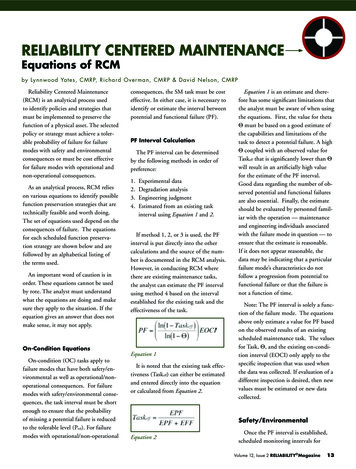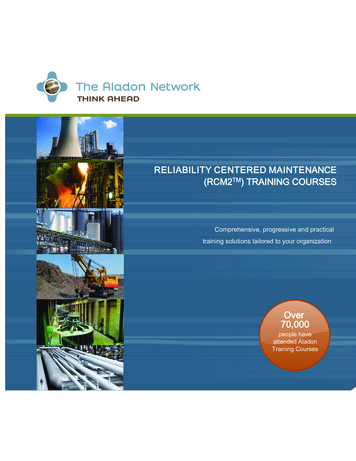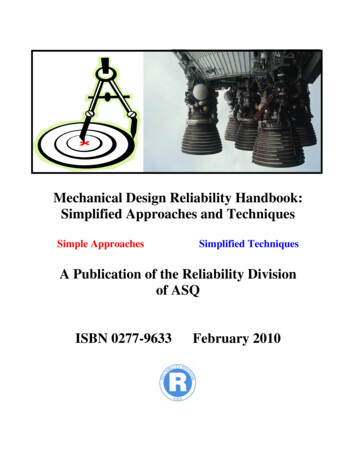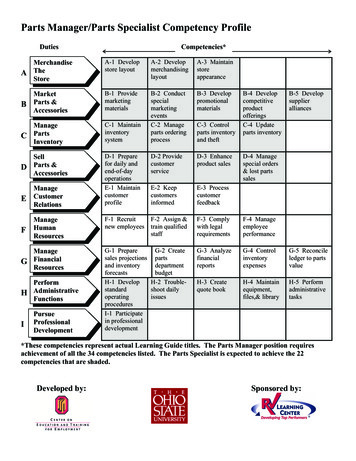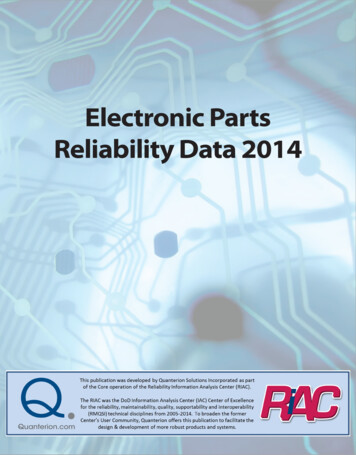
Transcription
Electronic PartsReliability Data 2014
Ordering Number: EPRD-2014Electronic PartsReliability Data2014Prepared by:Quanterion Solutions Incorporated100 Seymour Rd.Suite C101Utica, NY 13502-1311Prepared for:Reliability Information Analysis Center100 Seymour Rd.Suite C101Utica, NY 13502-1311
The information and data contained herein have been compiled from governmentand nongovernment technical reports and from material supplied by variousmanufacturers and are intended to be used for reference purposes. Neither theUnited States Government nor Quanterion Solutions Incorporated warrant theaccuracy of this information and data. The user is further cautioned that the datacontained herein may not be used in lieu of other contractually cited references andspecifications.Publication of this information is not an expression of the opinion of the UnitedStates Government or Quanterion Solutions Incorporated as to the quality ordurability of any product mentioned herein and any use for advertising orpromotional purposes of this information in conjunction with the name of theUnited States Government or Quanterion Solutions Incorporated without writtenpermission is expressly 4-67-4978-1-933904-67-2(CD-ROM)(CD-ROM)Copyright 2014 by Quanterion Solutions Incorporated. This hand book w as d eveloped by QuanterionSolutions Incorporated for the Departm ent of Defense Reliability Inform ation Analysis Center (RIAC) und erContract H C1047-05-D-4005. The Governm ent has a fully paid up perpetual license for free use of and access tothis publication and its contents am ong all the DOD IACs in both hard copy and electronic versions, w ithoutlim itation on the num ber of users or servers. Subject to the rights of the Governm ent, this d ocum ent (hard copyand electronic versions) and the content contained w ithin it are protected by U.S. Copyright Law and m ay notbe copied , autom ated , re-sold , or red istributed to m ultiple users w ithout the express w ritten perm ission. Thecopyrighted w ork m ay not be m ad e available on a server for use by m ore than one person sim ultaneouslyw ithout the express w ritten perm ission. If autom ation of the technical content for other than personal use, or form ultiple sim ultaneous user access to a copyrighted w ork is d esired , please contact 877.808.0097 (toll free) or315.732.0097 for licensing inform ation.
TABLE OF CON TEN TSPAGESECTION 1:1.11.21.31.4IN TRODUCTIONBackgrou nd . Data Collection . .Data Interp retation . . Docu m ent Overview . ectionSectionSectionSectionSection2 “Part Sum m aries” Overview . .3 “Part Details” Overview . .4 “Data Sources” Overview . .5 “Part N um ber/ MIL N um ber” Ind ex . .6 “N ational Stock N um ber Ind ex w ith Fed eral Stock Class ” . .7 “N ational Stock N um ber Ind ex w ithout Fed eral Stock Class Prefix” .8 “Part Description Ind ex” . 1-11-31-41-71-71-131-141-151-151-151-25SECTION 2:PART SUMMARIES2-1SECTION 3:PART DETAILS3-1SECTION 4:DATA SOURCES4-1SECTION 5:PART/ MIL N UMBER IN DEX5-1SECTION 6:N ATION AL STOCK N UMBER IN DEX WITH FEDERAL STOCK CLASS6-1SECTION 7:N ATION AL STOCK N UMBER IN DEX WITH OUT FEDERAL STOCK CLASS7-1SECTION 8:PART DESCRIPTION IN DEX8-1LIST OF TABLESTABLE 1-1:TABLE 1-2:TABLE 1-3:TABLE 1-4:TABLE 1-5:TABLE 1-6:DATA SUMMARIZATION PROCEDURECOMPON EN T GROWTH RATE FACTORS (FROM EPRD-97)FIELD DESCRIPTION SPART DESCRIPTION SAPPLICATION EN VIRON MEN TSCOMMON ABBREVIATION S1-31-61-81-91-91-14LIST OF FIGURESFIGURE 1-1:EXAMPLE OF PART SUMMARY EN TRIESiv1-12
EPRD-20141.0Introduction1-1INTRODUCTIONThis document represents a major update to the previous Electronic Part Reliability Data (EPRD-97)databook published over 15 years ago. Its purpose is to provide empirical field failure rate data onelectronic components. EPRD-97 data was limited to Capacitors, Diodes, Integrated Circuits,Optoelectronic Devices, Resistors, Thyristors, Transformers, and Transistors. EPRD-2014 adds millionsof hours of operating time and hundreds of failures to these component types, as well as adding (andupdating) field failure rate data on electronic Connectors, Relays, Switches, Inductors/Coils, previouslycontained only in the Reliability Information Analysis Center (RIAC) Nonelectronic Part Reliability Data(NPRD-2011) release.Reliability data is required to perform reliability assessments of systems. The part types for which datais contained in this document are those contained in existing reliability prediction methodologies, such asMIL-HDBK-217F, Notice 2 and. Whereas MIL-HDBK-217 and 217PlusTM contain mathematical modelsthat have been derived from empirical field failure rate data, the data contained in EPRD-2014 representshistorically observed field failure rates. This data can be used as an alternative to existing predictionmethodologies.Commercial quality components continue to be widely used in many applications, including militarysystems. Much of the data contained in this document relates to commercial quality components. It can,therefore, be used to predict reliability for both commercial and military systems containing commercialquality components.EPRD-2014, in combination with NPRD-2011, provides the capability of estimating the reliability ofmost component and assembly types used in electronic or mechanical systems.1.1 BackgroundAccurate and timely reliability predictions are an important part of a well structured reliability program.If properly performed, they can provide insight into the design and maintenance of reliable systems, aswell as provide initial estimates for sparing requirements.A potential use for this document is to complement existing reliability prediction methodologies byproviding failure rate data in a consistent format on various electronic component types when anorganization does not have its own database of failure rates for its own products/systems. Although thedata contained in this publication was collected from a wide variety of sources, the RIAC has carefullyand systematically screened the data such that only high quality data is added to the database andpresented in this document. In addition, only field failure rate data has been included.The user of this document should note that the use of reliability prediction techniques such as 217PlusTMor MIL-HDBK-217, or the use of the data contained in EPRD-2014, should complement (and must notreplace) sound reliability engineering and design practices. This document is meant to provide historicalreliability data on a wide variety of components to aid engineers in estimating the reliability of systems.Sound reliability engineering practices must include knowledge of the failure physics of all components,modules and interconnection assemblies in a system. Knowledge of life-limiting failure mechanisms,and how these mechanisms will behave in the intended use environment, is also necessary. Only in thismanner can robust designs be ensured.The intent of this introductory section is to provide the user with information to adequately interpret anduse the data. Since the primary purpose of this document is to augment reliability predictionmethodologies such as 217PlusTM and MIL-HDBK-217, a brief background of MIL-HDBK-217 will begiven, along with a description of how the data in this document can be used to augment it.100 Seymour Rd., Suite C101, Utica, NY 13502-1311 Ph: 877.808.0097
1-2 IntroductionEPRD-2014WHAT IS THE PURPOSE OF PERFORMING A RELIABILITY PREDICTION?1Predictions have several purposes, among them are:(1) feasibility evaluation(2) comparing competing designs(3) identification of potential reliability problems(4) to provide reliability input to other R/M tasksFeasibility evaluation involves evaluating the compatibility of a proposed design concept with the design reliabilityrequirements. Early in the system formulation process a feasibility evaluation would typically take the form of a parts counttype prediction (MIL-HDBK-217F, Appendix A) to determine "ballpark" compatibility with required reliability. Feasibilityevaluation may also take the form of a detailed parts stress type analysis (MIL-HDBK-217F, Sections 5-23) for componentsused in very high quantities. One example might be for phase shifter modules on a phased array antenna. Feasibilityevaluation is much more critical for totally new design concepts where no similar earlier system exists than for systems withknown reliability performance.Comparing competing designs is similar to the feasibility evaluation except that it extends through the design process andprovides one input, the predicted reliability, to be used in making broader system level design trade-off decisions involvingfactors such as cost, weight, power, performance, etc. A parts stress type prediction is typically refined to provide aquantitative means of estimating the relative cost-benefit of these and other system level trade-off considerations.Predictions which are properly performed provide a methodical means of checking all components for potential reliabilityproblems. By focusing attention on lower quality, over-stressed or misapplied parts a relative means of evaluating thereliability impact of these potential problem areas can be performed. It should be emphasized that the prediction itself doesnot improve system reliability; it only provides a means for identifying potential problems that, if corrected, will lead toimproved systems reliability. Therefore, predictions provide an excellent vehicle for government/contractor dialog inreviewing and evaluating the progress of the design prior to testing.Predictions provide key input to other R/M tasks such as maintainability analysis, testability evaluation and failure modes andeffects analysis (FMEA). Because predictions identify areas of relatively low reliability they provide key input to weigh thebenefits of adding test points, making areas more readily accessible for maintenance or adding redundancy to reduce the effectof a particularly critical failure mode.WHAT IS THE PURPOSE OF MIL-HDBK-217?MIL-HDBK-217 is intended to provide a consistent and uniform data base for making reliability predictions when nosubstantial reliability experience exists for a particular equipment. It contains two basic methods of calculating componentlevel failure rates, the "parts stress method" and the "parts count method." The parts count method requires only limitedinformation such as component type, complexity and part quality to calculate a part failure rate. The parts count section of thehandbook is derived by assigning model factors for more involved part stress method to slightly conservative estimates of whatwould typically be expected. All of the specific default values are provided in Appendix A of the handbook. The parts stressmethod requires significantly more information such as case or junction temperature and electrical operating and ratedconditions to perform a failure rate calculation. Prior to the development of the handbook, each contractor would have its ownunique set of data of which the source would have to be fully understood before meaningful design comparisons could bemade.It is not feasible for documents like 217PlusTM, MIL-HDBK-217, or other prediction methodologies tocontain failure rate models on every conceivable type of component and assembly. Traditionally,reliability prediction models have been primarily applicable only for generic electronic components.Therefore, EPRD-2014 serves a number of different needs, such as:1. Provide failure rate data on commercial quality components2. Provide failure rates on components in cases where data or analyses are not otherwiseavailable, feasible or required1excerpt from the Reliability Analysis Center (RAC) April 1990 Newsletter Technical Brief, written by Seymour Morris of Rome Laboratory.Quanterion Solutions Incorporated
EPRD-2014Introduction1-33. Complement 217PlusTM, MIL-HDBK-217 and other prediction methodologies by providingdata on part types not addressed by their respective models1.2 Data CollectionThe failure rate data contained in this document represent a cumulative compilation from the early 1970'sthrough July 2013. However, it should be noted that data is periodically purged from the database in theevent that newer data of higher quality is obtained. The RIAC is continuously soliciting new field data inan effort to keep the databases current. The goals of these data collection efforts are to:1. Obtain data on relatively new part types and assemblies2. Collect as much data on as many different data sources, application environments, andquality levels as possible3. Identify as many characteristic details as possible, including both part and applicationparametersThe RIAC utilized the following generic sources of data for EPRD-2014: Published reports and papersData collected from government-sponsored studiesData collected from military maintenance data collection systemsData collected from commercial warranty repair systemsData from commercial/industrial maintenance databasesData submitted directly to RAC from military or commercial organizations that maintain failuredatabasesBrief descriptions are provided of the sources utilized in this document. Each summarized failure ratecan be mapped to one of these data sources. An example of the process by which RIAC identifiescandidate systems and extracts reliability data on military systems is summarized in Table 1-1.Table 1-1: Data Summarization Procedure(1)Identify System Based On: Environments/QualityAgeComponent TypesAvailability of Quality Data(2)Build Parts List: Obtain Illustrated Parts Breakdown (IPB)/Bill of Materials(BOM)Ensure Correct Version of System Consistent withMaintenance DataIdentify Characteristics of Components (Part Numbers, FederalStock Number, Microfiche, Vendor Catalogs, etc.)Enter Part Characteristics into Database (3)Obtain Failure Data: Reliability Improvement Warranty, DO56, Warranty RecordsMatch Failures to IPB/BOMEnsure Part Replacements Were Component FailuresAdd Failure Data to Database(4)Obtain Operating Data: Verify Equipment InventoryEquipment Hours, Part HoursApplication Environment(5)Transform Data to Common RIAC Database Template100 Seymour Rd., Suite C101, Utica, NY 13502-1311 Ph: 877.808.0097
1-4 IntroductionEPRD-2014Perhaps the most important aspect of this data collection process is identifying viable sources of highquality data. Large automated maintenance databases, such as the Air Force REMIS system or theNavy's 3M/AV-3M/DeckPlate system, typically will not provide accurate data down to the piece-partlevel. They do, however, provide relevant data on assemblies or LRUs, if used judiciously.Additionally, there are specific instances in which they can be used to obtain piece-part data. Piece-partdata from these maintenance systems is used in the RIAC's data collection efforts only when it can beverified that they accurately report data at this level. Reliability Improvement Warranty (RIW) data areanother high quality data source which has been used by the RIAC. Section 4 of this document containsa brief description of each data source used in this publication, because the RIAC believes it is importantfor the user to understand the types of data that were used in deriving the published failure rates.The RIAC has done everything possible to ensure that only the best data available is published in thisdocument. Completeness of data, consistency of data, equipment population tracking, failureverification, availability of parts breakdown structure, and characterization of operational histories are allused to determine the adequacy of the data. In many cases, data submitted to the RIAC is discarded sincea reasonable degree of credibility cannot be established.Inherent limitations in data collection efforts can result in errors and inaccuracies in summary data. Caremust be taken to ensure that the following factors are considered when using a data source. There are many more factors affecting reliability than can be realistically identifiedThere is a degree of uncertainty in any failure rate data collection effort. This uncertainty isdue to the following factors:– Uncertainty as to whether the failure was inherent (common cause) or event-related(special cause).– Difficulty in distinguishing between primary and secondary failures– Much data collected is generic and not manufacturer specific, indicating that variations inthe manufacturing process are not accounted forIt is very difficult to distinguish between the effects of highly correlated variables. Forexample, the fact that higher quality components are typically used in more severeenvironments makes it impossible to independently distinguish the effect that each has onreliability.Operating hours can be reported inaccuratelyMaintenance logs can be incompleteActual component stresses are rarely known. Even if nominal stresses are known, actualstresses which significantly impact reliability can vary significantly about this nominal value.When collecting field failure data, a very important variable is the criteria used to detect and classifyfailures. Much of the failure data presented in this publication is identified initially by maintenancetechnicians performing a repair action, indicating that the criteria for failure is that a part in a particularapplication has failed in a manner that makes it apparent to the technician. In some data sources, thecriteria for failure were that the component replacement must have remedied the failure symptom. Adescription of these sources is provided in Section 4 of this document.1.3 Data InterpretationData contained in this document reflects industry average failure rates, especially the summary failurerates which were derived by combining several failure rates on similar parts/assemblies from varioussources. In certain instances, reliability differences can be distinguished between manufacturers orbetween detailed part characteristics. Although the summary section cannot be used to identify thesedifferences (since it presents summaries only by generic type, quality, environment, and data source), theQuanterion Solutions Incorporated
EPRD-2014Introduction1-5listings in the detailed section contain all specific information that was known for each part and,therefore, can sometimes be used to identify such differences.Data in the Section 2 of EPRD-2014 represents an "estimate" of the expected failure rate. The "true"value will lie in some confidence interval about that estimate. The traditional method of identifyingstatistical confidence limits for components with exponentially distributed lifetimes has been the use ofthe Chi-Square distribution. This distribution relies on the observance of failures from a homogeneouspopulation and, therefore, has limited applicability to merged data points from a variety of sources.To give users of this document a better understanding of the confidence they can place in the presentedfailure rates, an analysis was performed on the variation in observed failure rates. It was concluded that,for a given generic part type, the natural logarithm of the observed failure rate is normally distributedwith a sigma of 1.5. This indicates that 68 percent of actual failure rates will be between 0.22 and 4.5times the mean value. Similarly, 90% of actual failure rates will be between 0.08 and 11.9 times thepresented value. This type of precision is typical of probabilistic reliability prediction models and pointestimate failure rates such as those contained herein. It should be noted that this precision is applicableto predicted failure rates at the component level, and that confidence will increase as the statisticaldistributions of components are combined when analyzing assemblies or systems.The time period over which the data is collected is also an important attribute when interpreting the data.Many component types exhibit infant mortality behavior, which is characterized by a decreasing failurerate as a function of time. This observation is due to the fact that the failure rates of many componenttypes are driven by defects which occur in a small percentage of the part population. Once these defectshave manifested themselves as failures, the failure rate decreases. Therefore, the failure rate forcomponent types exhibiting these infant mortality characteristics will appear higher if the data wascollected in the early life compared to being collected later in the component's life. As a result, datacollected from warranty repair records may exhibit failure rates higher than data collected frommaintenance records throughout an equipment's life because warranties are typically only applicable tothe early life. The reader is, therefore, encouraged to review the description of the data sources inSection 4 to gain a better understanding of specific data points.It is also necessary to understand a component type’s age when interpreting the data contained in thisdocument. The reason for this is that many electronic part types have experienced reliability growthwhich has resulted from the reliability improvement efforts of the component manufacturers. Somecomponents, such as integrated circuits, have historically experienced a large rate of growth, whileothers, such as resistors, have experienced a slower growth rate. (It should be noted, however, thatrecent advances in the miniaturization of integrated circuit semiconductor technologies may have slowed,or even reversed, this rate of growth through the introduction (or re-introduction) of predominant failuremechanisms resulting from shrinking geometries and the use of new semiconductor and solderingmaterials.)An analysis of the data has been performed to quantify the rate of reliability growth as a function of theyear of component manufacture. A model of the following form was used to quantify the growth rate: Ae Btwhere, Failure rate (F/106 hrs)A Constant100 Seymour Rd., Suite C101, Utica, NY 13502-1311 Ph: 877.808.0097
1-6 IntroductionEPRD-2014B Growth ratet Time in yearsTable 1-2 summarizes the values of B derived for various component types. As an example of how thisgrowth effect can be interpreted, consider a plastic encapsulated microprocessor microcircuit whose Bvalue is 0.526. In this example, the failure rate for these devices has improved between 1990 and 1995by an average factor of:e 0.526(1995 1990) 0.72It is suggested that the user of this data review the data source descriptions in Section 4 of this documentto determine the age of specific data when it appears in the data source descriptions. The dates providedare indicative of the dates over which the data was collected, not the date of part manufacture. Note,however, that Table 1-2 reflects the data as published in EPRD-97. This table has not been updated forEPRD-2014, so it does not reflect the potential caveats in reliability growth rate mentioned previously.Table 1-2: Component Growth Rate Factors (from EPRD-97)Part TypeElectrolytic CapacitorsNon-Electrolytic CapacitorsResistorsRectifier DiodesZener DiodesOther DiodesBipolar TransistorsFET TransistorsDarlington TransistorsBipolar Digital Microcircuits(Plastic Encapsulated)Bipolar Linear Microcircuits(Plastic Encapsulated)MOS Digital Microcircuits(Plastic Encapsulated)MOS Digital Microprocessors(Plastic 0.3970.2690.5520.1970.4750.526The growth rate data is provided so that the user can quantify a "typical" reliability improvement fromthe time at which the data was collected to the present. While this data can be used to calculate animprovement factor and modify the failure rates presented herein accordingly, the user is cautioned thatthis procedure will add a degree of uncertainty in the resultant failure rate estimate. This is due to theassumption that the growth rate continues at a (logarithmically) constant rate in accordance with theabove equation. Therefore, extrapolation of the failure rate increases the level of uncertainty, and theuncertainty increases with the extrapolation distance.It should be stressed that the data in this document should not be used to form general conclusions or toguide policy decisions. For example, data for a particular device in the summary section may indicatethat a lower quality level part is more reliable than a high quality part. This situation could occur when ahigher quality part is overstressed or otherwise misapplied in the design. It cannot be concluded thatquality has an inverse effect on reliability. In this situation, the data collected was either not adequate toaccurately identify the difference or there were too many uncontrolled and unidentified variablesinherent in the data.Quanterion Solutions Incorporated
EPRD-2014Introduction1-7In virtually all field failure data collected by the RIAC, time-to-failure (TTF) was not available. FewDoD or commercial data tracking systems report elapsed time indicator (ETI) readings to allow TTFcomputations. Those that do report ETI readings lose accuracy following removal and replacement offailed items. To accurately monitor these times, each replaceable item would require its own individualtime recording device. The RIAC's data collection efforts typically track only the total number of itemfailures, part populations, and the number of system operating hours. This means that the assumedunderlying TTF distribution for all failure rates presented in this document is the exponential.1.4 Document OverviewThis document has been organized into the following sections:Section 1:Section 2:Section 3:Section 4:Section 5:Section 6:Section 7:Section 8:IntroductionPart SummariesPart DetailsData SourcesPart Number/Mil Number IndexNational Stock Number Index with Federal Stock Class PrefixNational Stock Number Index without Federal Stock Class PrefixPart Description IndexSections 2 through 8 are described in detail in the following pages.1.4.1 Section 2 "Part Summaries" OverviewThe summary section of this document contains combined failure rate data, sorted in order of PartDescription, Quality Level, Application Environment, and Data Source. The Part Description itself ispresented in a hierarchical classification. The known technical characteristics, in addition to theclassification, are contained in Section 3, “Part Details”. All data records were combined by totaling thefailures and operating hours from each unique data source. In some cases, only failure rates werereported to RIAC. These data points do not include specific operating hours and failures, and havedashes in the Total Failed and Operating Hours/Miles/Cycles fields. Table 1-3 describes each fieldpresented in the summary section.100 Seymour Rd., Suite C101, Utica, NY 13502-1311 Ph: 877.808.0097
1-8 IntroductionEPRD-2014Table 1-3: Field DescriptionsField#Field NameField Description1Part DescriptionDescription of part including the major family of parts and specific part typebreakdown within the part family. The Part Description used in this documentis presented in levels of classification. The first level is used to describe thegeneric function/description of the part and the remaining levels are used asmore detailed descriptions of the part. Table 1-4 summarizes the descriptionsfor each level associated with each component type.In some cases, only generic part descriptions were supplied to the RIAC. Forthese, detailed part descriptions are not known.2Quality LevelThe Quality Level of the part as indicated by:Commercial - Commercial quality partsMilitary - Parts procured in accordance with MIL specificationsUnknown - Data resulting from a device of unknown quality level3App. Env.The Application Environment describes the conditions of field operation. SeeTable 1-5 for a detailed list of application environments and descriptions.These environments are consistent with MIL-HDBK-217. In some cases,environments more generic than those used in MIL-HDBK-217 are used. Forexample: "A" indicates the part was used in an Airborne environment, but theprecise location and aircraft type was not known. Additionally, some are morespecific than the current version of MIL-HDBK-217 since the current versionhas merged many of the environments and the data was originally categorizedinto the more specific environment. Environments preceded by the term "No"are indicative of components used in a non-operating system in the specifiedenvironment.4Data SourceSource of data comprising this entry. The source number may be used as areference to Section 4 to review individual data source descriptions.5Failure RateFails / (E6)The failure rate presented for each part type, environment, quality, and source.It is the total number of failures divided by the total number of life units. Noletter suffix indicates the failure rate is in failures per million hours. An "M"suffix indicates the unit is failures per million miles. A “C” suffix indicatesthe unit is failures per million cycles. For roll-up data entries (i.e., thosewithout sources listed), the failure rate is derived using the data mergealgorithm described in this section. A failure rate preceded by a " " isrepresentative of entries with no failures. The failure rate listed was calculatedby using a single failure divided by the given number of life units. Theresulting number is a worst case failure rate and the real failure rate is less thanthis value. All failure rates are presented in a fixed format of four decimalplaces after the decimal point. The user is cautioned that the presented datahas inherently high variability and that four decim
electronic components. EPRD-97 data was limited to Capacitors, Diodes, Integrated Circuits, Optoelectronic Devices, Resistors, Thyristors, Transformers, and Transistors. EPRD-2014 adds millions of hours of operating time and hundreds of failures to these component types, as well as adding (and updating) f


